
Browse an alphabetical list of photographs. These historical images portray people, places, and events before, during, and after World War II and the Holocaust.
<< Previous | Displaying results 201-225 of 2641 for "Photo" | Next >>
Defendant Albert Speer during the International Military Tribunal trial of war criminals at Nuremberg. Germany, between November 20, 1945, and October 1, 1946.
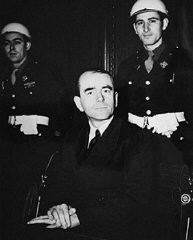
The defendants and their lawyers at the International Military Tribunal trial of war criminals at Nuremberg. Defendant Albert Speer (standing at right) delivers a statement in the dock. Nuremberg, Germany, November 20, 1945-October 1, 1946.
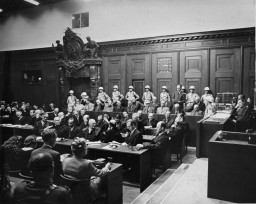
Aleksander Belev, Bulgarian commissioner for Jewish Affairs (center, wearing hat and facing the camera), oversees the deportation of Jews. Skopje, Yugoslavia, March 1943.

Alexander G. Hardy, associate counsel for the prosecution, during the Doctors Trial. Nuremberg, Germany, December 9, 1946-August 20, 1947.
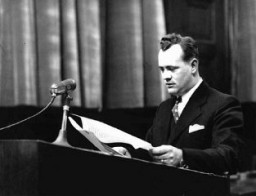
Alexander White in Chicago, 1948, after he immigrated to the United States. Nearly 40 years later Alex would run into the only other survivor of the Bor labor camp that Alexander fled from to join the partisans.
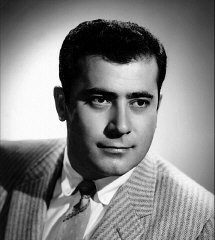
Former Nazi Party ideologist Alfred Rosenberg on trial at the International Military Tribunal war crimes trial. Nuremberg, Germany, April 15, 1946.
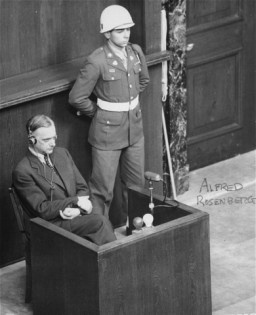
Defendant Alfred Rosenberg, the former chief Nazi Party ideologist, reads a document during the International Military Tribunal trial of war criminals at Nuremberg. Behind him is his co-defendant General Alfred Jodl, formerly the Chief of Staff for the Army. Nuremberg, Germany, 1945–1946.
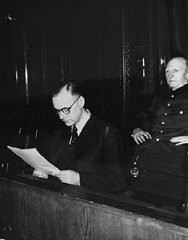
Alfred Rosenberg's 1923 commentary on the Protocols reinforced Nazi anti-Jewish ideology. This is the fourth edition. Published in Munich, 1933.

Alice and Heinrich Muller pose for a photograph while in costume for the Purim holiday. Hlohovec, Czechoslovakia, ca. 1934–35.
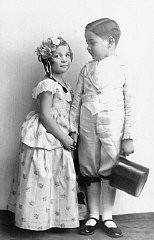
The Aliyah Bet ("illegal" immigration) ship Parita, carrying 850 Jewish refugees, lands on a sandbank off the Tel Aviv coast. The British arrested the passengers and interned them at Atlit detention camp. Palestine, August 21, 1939.
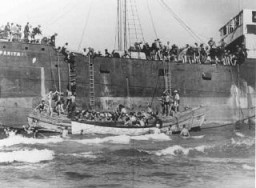
Aliyah Bet ("illegal" immigration) ship Tiger Hill, carrying Jewish refugees from Europe, lands in Tel Aviv, Palestine. Jewish residents of Palestine greet the ship. September 1, 1939.
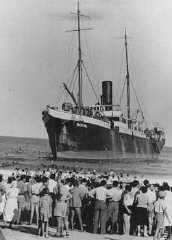
Jewish refugees on board the Aliyah Bet ("illegal" immigration) ship Atrato. The ship was caught by the British off the coast of Jaffa, Palestine, and escorted to Haifa port. July 17, 1939.
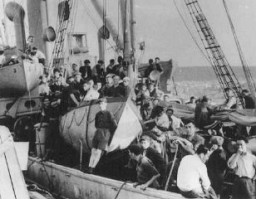
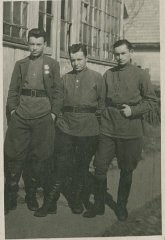
Allied delegates in the Hall of Mirrors at the palace of Versailles witness the German delegation's acceptance of the terms of the Treaty of Versailles. The treaty formally ended World War I. Versailles, France, June 28, 1919.
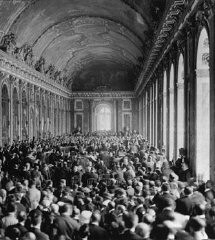
Allied troops board amphibious assault boats off the Algerian coast during Operation Torch. North Africa, November 1942.
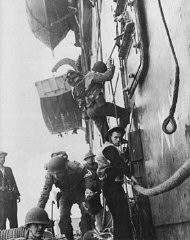
Allied troops march in Tunis following Allied success against Axis forces in the African Campaign. Tunis, Tunisia, May 20, 1943.
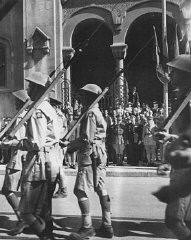
Alter Dvoretsky, head of the Zhetel Judenrat (Jewish council) and leader of the Zhetel underground.
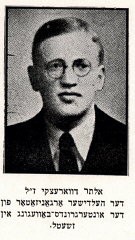
1949 photograph of Amalie and Norman Salsitz in Brooklyn, New York, two years after they came to the United States. With the end of World War II and collapse of the Nazi regime, survivors of the Holocaust faced the daunting task of rebuilding their lives. With little in the way of financial resources and few, if any, surviving family members, most eventually emigrated from Europe to start their lives again. Between 1945 and 1952, more than 80,000 Holocaust survivors immigrated to the United…
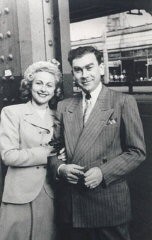
Amalie and Norman Salsitz go to Israel to visit family members. Lod (Lydda), Israel, February 9, 1949. With the end of World War II and collapse of the Nazi regime, survivors of the Holocaust faced the daunting task of rebuilding their lives. With little in the way of financial resources and few, if any, surviving family members, most eventually emigrated from Europe to start their lives again. Between 1945 and 1952, more than 80,000 Holocaust survivors immigrated to the United States. Norman was one of…
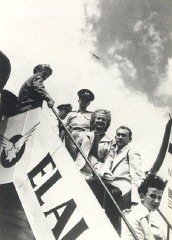
June 6, 1991, photograph showing Amalie and Norman Salsitz with a copy of their book, Against All Odds. With the end of World War II and collapse of the Nazi regime, survivors of the Holocaust faced the daunting task of rebuilding their lives. With little in the way of financial resources and few, if any, surviving family members, most eventually emigrated from Europe to start their lives again. Between 1945 and 1952, more than 80,000 Holocaust survivors immigrated to the United States. Norman was one of…
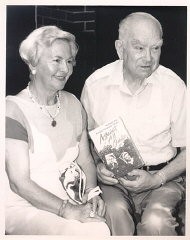
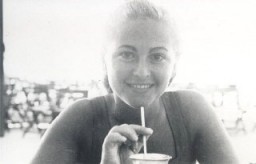
Amalie Petranka (later Salsitz) at 22 years of age. She gave this photo to Norman Salsitz shortly after they met. Photograph taken in Stanislawow, Poland, on October 10, 1939.
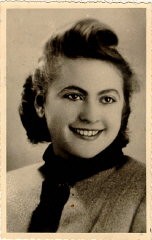
Amalie (left) with her grandmother and sister Pepka in Tel Aviv, Israel, 1949.
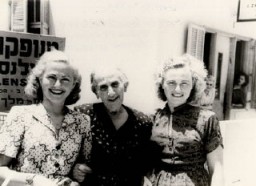
Members of the Amarillo family pose outside their home in Salonika. Front, from left to right, are Tillie Amarillo and Sarika Yahiel. Seated behind them are their mothers Louisa Bourla Amarillo and Regina Amarillo Yahiel. Standing are Saul Amarillo, Isaccino Yahiel, and Isaac Yahiel. Salonika, Greece, between 1930 and 1939.
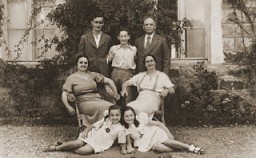
African American athletes Jesse Owens and Dave Albritton pose with a German citizen. They both competed in the 1936 Olympic Games. Albritton won the silver medal in high jump. Owens won gold medals in the 100-meter dash, 200-meter dash, broad (long) jump, and the 4x100-meter relay.
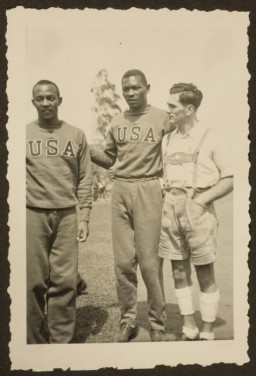
We would like to thank Crown Family Philanthropies, Abe and Ida Cooper Foundation, the Claims Conference, EVZ, and BMF for supporting the ongoing work to create content and resources for the Holocaust Encyclopedia. View the list of donor acknowledgement.